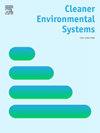Water footprint and sustainable development goals: A bibliometric, semantic, and thematic analysis in economic-administrative sciences
IF 4.9
Q2 ENGINEERING, ENVIRONMENTAL
引用次数: 0
Abstract
A common misconception persists that water conservation primarily involves efficient use in domestic activities. While such practices are undeniably important, they account for only 4 % of daily water consumption. The remaining 96 % is embedded—directly or indirectly—in the products and services that are used, known as virtual water. This hidden water use is quantified through the water footprint indicator, a member of the environmental footprint family, which reveals how production and consumption choices impact water resources. This study conducts an objective, exhaustive, and meticulous examination of existing water footprint research through a systematic literature review, complemented by bibliometric, semantic, and thematic analyses. Framed within the Sustainable Development Goals (SDGs) and viewed through the lens of economic-administrative sciences, this approach contextualizes the topic, identifies understudied areas, uncovers subtle relationships between variables, and maps patterns and trends in scientific production.
The results highlight the necessity of a comprehensive approach to studying the water footprint, given its inherent complexity and the interdependencies among multiple influencing factors.
水足迹和可持续发展目标:经济管理科学的文献计量学、语义和专题分析
一个普遍的误解仍然存在,认为节约用水主要是在家庭活动中有效利用。不可否认,这些做法很重要,但它们只占日常用水量的4%。剩下的96%直接或间接地嵌入到所使用的产品和服务中,被称为虚拟水。这种隐性用水通过水足迹指标进行量化,水足迹指标是环境足迹家族的一员,它揭示了生产和消费选择如何影响水资源。本研究通过系统的文献综述,辅以文献计量学、语义学和专题分析,对现有的水足迹研究进行了客观、详尽和细致的考察。在可持续发展目标(SDGs)的框架内,通过经济-行政科学的视角,这种方法将主题置于背景中,确定研究不足的领域,揭示变量之间的微妙关系,并绘制科学生产的模式和趋势。鉴于水足迹的内在复杂性和多个影响因素之间的相互依赖性,研究结果强调了综合研究水足迹的必要性。
本文章由计算机程序翻译,如有差异,请以英文原文为准。
求助全文
约1分钟内获得全文
求助全文
来源期刊

Cleaner Environmental Systems
Environmental Science-Environmental Science (miscellaneous)
CiteScore
7.80
自引率
0.00%
发文量
32
审稿时长
52 days
 求助内容:
求助内容: 应助结果提醒方式:
应助结果提醒方式:


